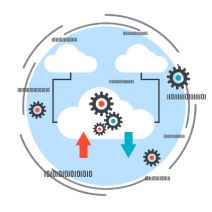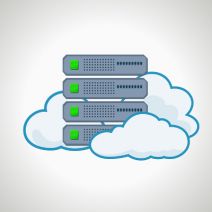As important as it is to keep your technology up-to-date, it can sometimes be prohibitively expensive to do so throughout your entire business. If you have found yourself in this position, one option you may consider is to resort to hosted desktop solutions. Here, we’ll go over what a hosted desktop is, and how it can serve companies well.
Directive Blogs
Cloud services have proven to be extraordinarily useful for businesses of all types. With an immense amount of options to choose from, businesses can get anything from AI to Windows in the cloud. With so many services available, sometimes businesses will pay for computing resources that they don’t use, cutting into their available operational capital. Today, we take a look at how businesses throw capital away by not keeping a close eye on their cloud-based resources.
When you look at the cloud service business model, it can be easy to wonder how it is so beneficial to businesses - or really, how it fiscally can be. After all, dollars to donuts, the monthly service charges most likely add up to less than a business would spend for another, comparable service. To understand how the cloud does this, it may help to look at something that often occurs in the office.
Microsoft offers solutions that have a proven history of being assets when businesses adopt them - but like most any solution, what may fit well for one, may not fit well for all. Here, we’ll consider one of Microsoft offerings to help you determine if it is the right solution for your needs and requirements.
Cloud-based databases are valuable for businesses on plenty of levels, but when you consider how much risk you expose your organization to by using a public cloud over a private solution, you suddenly start to realize that the ramifications could be far beyond repair. Compared to the public cloud, a private solution presents a greater opportunity for security, flexibility, and customization.
If your business is looking to use technology beneficially, the ability to store data is going to be a major consideration you are going to have to confront. After all, not having enough storage space, or having too much, can be major problems for most businesses. Today, we’ll ask some of the most pressing questions you’ll need to answer to get the right (and the right amount of) storage space for your needs.
Virtualization has opened up a lot of doors for businesses who want to make their operations more flexible, but your business can’t simply implement it all willy-nilly. You need to have specific requirements in mind for your cloud hardware. This week’s tip is dedicated to helping you make the best decisions possible regarding the adoption of virtualization for your business’ needs.
The cloud is the perfect outlet for businesses to improve productivity, but the degree to which this statement is true depends on the business and how much it leverages the cloud. If you’re not sure if your business can be utilizing the cloud in a more efficient way, perhaps we can help you make this determination and improve the way you take advantage of this technology.
No matter how big a business is, it has to leverage at least some IT in order to be efficient. Unfortunately, some organizations are reluctant to implement new technology if they don’t seem to need it immediately. What these businesses don’t know is that the reason they typically don’t implement new solutions--saving money--is in direct conflict with what the solutions are designed to do in the first place.
The cloud has helped many businesses push beyond their limits, but is your organization taking advantage of it? Depending on the needs of your specific business, the cloud can benefit your organization in ways you could never dream of just 20 years ago. We’ll go through some of the best ways the cloud can help your organization.
Nowadays, businesses take advantage of so many solutions that it can be challenging just to keep them all in line, let alone managing and maintaining them all. Of course, the most difficult part of using so much technology is affording it. While you could certainly invest in software licenses for each and every one of you users’ systems, there is an alternative that you should certainly consider.
Were you among the 55.3 percent of employees who took their work devices on the road during this past holiday season? Chances are that if you have employees who find it difficult to complete their duties in the office, they’ll take it home with them over the holidays to make sure they don’t fall behind. Yet, they could potentially be exposing important data to risk, even if it means getting a little bit of work done here and there in the meantime.
Evernote is a neat note-taking app that many users have found works for them, as it can be used to keep notes organized in a better way than a traditional notebook. With new features that can offer you plenty of functionality, Evernote might just be the note-taking solution you’ve been looking for all these years. This week’s tip is dedicated to one of the best new features of Evernote: templates.
These days, many businesses turn to hosted solutions to take advantage of services that they haven’t been able to use in the past. Whether it’s because they don’t have the staff to properly look after the services or they don’t have the in-house infrastructure for it, organizations continue to take advantage of hosted solutions to varying degrees. We’ll walk you through your options for whether you should build, rent, or buy your hosted solutions to best fit your business’ needs.
The cloud is such an important part of today’s business environment that most organizations use it to some extent, even if it’s just for basic storage needs. However, the cloud needs to be properly maintained, starting with the way you secure your cloud services. Take a moment to ask yourself if your cloud--whether it’s hosted on-site or by a provider--is safe and secure.
A connectivity to the cloud is a great opportunity that your organization can leverage to its advantage, but only if it’s done well. No two businesses will have the same exact configuration when it comes to cloud, as the needs and responsibilities that are accomplished through that cloud solution will change. This week’s tip is dedicated to helping you discover which cloud solution is right for you.
Regardless of where it is kept, your data’s security is of paramount importance. However, this doesn’t mean that the decision between leveraging the cloud or an on-premise server for your data storage needs isn’t an important one. For this week’s tip, we’ll weigh these options against each other to help you establish which is the better option for your business’ needs.
Data management is exceptionally important for any business, and companies that use the cloud in any sort of capacity need to be considerably more cautious in the way that it’s managed than a business that only hosts data on an internal server or network. The cloud makes things more complicated at times, but if managed correctly, it can lead to unprecedented efficiency for your organization.
Did you know that 43 percent of IT decision makers have plans to increase their cloud investments throughout 2017? This is according to a recent survey which, when combined with the steady rate of cloud adoption seen during the past decade, proves that the cloud is the next phase in the evolutionary development of business computing. While this shows great promise for the future, cloud adoption is not something to dive into blindly.
Are you still hesitant to adopt cloud computing for your company’s IT needs? For the cautious business owner, adopting new technologies isn’t a move that’s to be made lightly. However, cloud computing is much more than a passing fad. In recent years, the cloud has become such a reliable and efficient tool for businesses that it deserves your attention. Take for example these three misconceptions about the cloud.
When you hear us speak the world “cloud,” it’s not the fluffy white forms soaring overhead. The cloud that we refer to are computing systems that are delivered to you through an Internet connection. The popularity and demand for cloud services has led both ordinary consumers and businesses alike to seek them out. Despite this demand, in the United States alone, there are over 500,000 IT jobs available. This suggests that there may be a shortage of workers with the requisite skillset and can provide a unique incentive to join the industry as to take advantage of such massive growth.
Smart organizations are always looking for ways to improve how they do business. Digital transformation is a way for businesses to get the most out of their technology by improving workflows and overall efficiency. What does digital transformation look like and how can you implement it in your business?
Technology is a big deal for the modern business. This doesn’t mean just your organization’s workstations and servers either. Today there is a big shift in the way that small-to-large businesses get the computing resources they need to succeed. As cloud-based offerings continue to offer organizations computing options they haven’t had before, one hosted solution stands out for the value it presents: file sharing.
Technology is a necessity for businesses everywhere if they are to reach their goals, which are themselves influenced by the technology that businesses have access to. If this cycle is to continue, a business needs to establish what is expected to come next in the line of IT innovation. From the looks of it, businesses are currently placing convenience in high regard.
The cloud helps many organizations expand their territories beyond simply the physical workplace. Employees can now access data and applications on any connected device. Your office can benefit considerably from cloud-based resources, with email in particular being a standout solution for the cloud.
The cloud has revolutionized the way that businesses approach computing. Companies can implement solutions in a flexible and accessible model that makes it much easier to take advantage of technology solutions. Yet, you should know that not all clouds are the same, and you can’t treat them as such. Here are four questions that you need to ask your cloud provider about the services that you’ve been rendered.
It can be argued that your organization isn’t considered “modern” without taking advantage of truly modern technology solutions. This includes the cloud, which provides anytime-anywhere access to important information or products. This type of access--also known as Product as a Service--can help your budget by eliminating large up-front costs in favor of smaller payments more regularly. This might seem ideal for your organization, but we urge you to take a step back and think about the solution before accepting terms of service without looking for extra hidden costs.
Cloud computing is a major player in the way that businesses are approaching their daily operations. This might bring into question whether or not your organization is actually using the cloud in the first place, but one thing is certain--if you haven’t implemented the cloud yet, it’s difficult to not do so, especially considering how great it can be for your company.
Many business transactions may be moving away from the telephone, but it is still a must-have for any business. Not everyone is Internet-savvy after all. Nowadays, there are plenty of telephone options out there, but only one carries no upfront hardware costs or a exorbitant fee structure: Hosted VoIP. Today, we will take a look at the benefits of cloud hosted VoIP, and how to get one working for your business today.
As the cloud is being utilized by more individuals and organizations to meet their computing needs, more very important data is hosted outside of local computer networks. As a result, people utilize cloud storage for their backup and recovery strategies. In fact, it has become the primary use of cloud-hosted platforms, but just how does backup and recovery from these collaborative cloud-based platforms work?
The cloud has seen explosive use of its services and solutions since it was first introduced, and for good reason--it offers benefits that are too useful for a business to pass up. These benefits vary, but all serve a singular purpose: to make the user’s experience easier. Here are some of the ways that the cloud can enhance the daily operations of your business.
Cloud computing offers businesses an economical way to obtain the software and services they need. Yet, there comes a point when having too much of a good thing becomes wasteful, no matter how affordable the service may be. If a business owner isn’t careful about how they utilize the cloud, then they can unknowingly find themselves experiencing “cloud waste.”
If you’re like most small businesses, chances are that you have one or two servers in your office that are dedicated to storing and distributing data on your in-house network. Without these machines, you would be in a rough spot. Users wouldn’t be able to access data and your operations would suffer. But what if we told you that there is an easier way to manage data and increase user accessibility that doesn’t include managing server hardware?
Your business relies on technology to ensure operations proceed smoothly, but the way that it’s managed can have a major impact on the way your company functions. Think about it like this: if you have software solutions hosted on different computers, but not in any centralized location, only those computers will be able to use these solutions--potentially hampering your staff’s ability to be productive. How can you make sure that this doesn’t become a major problem?
One of the inevitabilities of working with the cloud is that you have to face a tough question; what kind of compliance requirements are there for cloud-based data? If you’re storing data for your business in a cloud-based environment, it becomes your responsibility to know where and how this data is stored--particularly if you’re not the one doing the actual cloud hosting. How do you maintain compliance when you seemingly have so little control over how your computing platform is managed and maintained?
If you think that working with the cloud doesn’t have risks, think again. It’s inevitable that you’ll face security compliance concerns when it comes to your cloud-based data. If your organization has data stored in a cloud-based environment, you’ll want to pay particularly close attention to how compliance laws affect the way that you access and store this information. How can you make sure that your cloud-based data isn’t in violation of some cloud compliance laws?
The traditional computing structure has been under siege by cloud computing for the past several years. More businesses than ever are seeing the value in cloud-hosted applications and infrastructure, and while that may not be a huge surprise, the perceptions that the cloud can solve any of your organizational computing problems depend largely on the needs of that endeavor. Today, we will take a look at successful small business cloud strategies and tell you why they find success.
By now, you've heard about the many advantages of hosting your data and applications in the cloud. To take advantage of these money-saving benefits, you'll want to select the right cloud provider to host and manage your data. Otherwise, you may end up with poor support and disappointing service.
To help you pick the right hosting provider, you first need to familiarize yourself with your options. Here's a walkthrough of what you need to look for.
 A short time ago, cloud computing was a resource that was only taken advantage of by organizations that could afford to virtualize and manage their hosted platforms. Nowadays, many businesses, including startups, are using cloud computing for their organization’s primary computing functions. As this enormous shift happened, many of the world’s largest companies have pushed their cloud platforms forward to offer secure storage, software deployment, and even communications for organizations that are either just starting out, or are looking to reduce their capital computing and support costs.
A short time ago, cloud computing was a resource that was only taken advantage of by organizations that could afford to virtualize and manage their hosted platforms. Nowadays, many businesses, including startups, are using cloud computing for their organization’s primary computing functions. As this enormous shift happened, many of the world’s largest companies have pushed their cloud platforms forward to offer secure storage, software deployment, and even communications for organizations that are either just starting out, or are looking to reduce their capital computing and support costs.
 Microsoft Office 365 offers many different solutions that allow your employees to be able to do their jobs, keep everything organized, and communicate efficiently. Although, it can be tricky to select a good Office 365 plan for your business. To help streamline operations, the Microsoft Office 365 Business Premium edition offers a versatile selection that can meet any needs your business may encounter.
Microsoft Office 365 offers many different solutions that allow your employees to be able to do their jobs, keep everything organized, and communicate efficiently. Although, it can be tricky to select a good Office 365 plan for your business. To help streamline operations, the Microsoft Office 365 Business Premium edition offers a versatile selection that can meet any needs your business may encounter.
 The cloud is revolutionizing the way that businesses store and manage data, applications, and even abstracted hardware like servers and desktops. However, some businesses are still reluctant to adopt the cloud, despite its overwhelming advantages for small and medium-sized organizations. Therefore, we’re taking it upon ourselves to “demystify” the cloud, so you can see just how great of an innovation it is.
The cloud is revolutionizing the way that businesses store and manage data, applications, and even abstracted hardware like servers and desktops. However, some businesses are still reluctant to adopt the cloud, despite its overwhelming advantages for small and medium-sized organizations. Therefore, we’re taking it upon ourselves to “demystify” the cloud, so you can see just how great of an innovation it is.
 There comes a time when your business needs to upgrade its technology. Holding out for as long as possible might seem beneficial for your wallet, but in the end, it’s much more cost-effective to replace outdated and inefficient technology before it winds up becoming a liability. In many cases, businesses might not even realize how much their outdated technology is hurting their bottom line. How can you know with certainty that it’s time to upgrade your technology?
There comes a time when your business needs to upgrade its technology. Holding out for as long as possible might seem beneficial for your wallet, but in the end, it’s much more cost-effective to replace outdated and inefficient technology before it winds up becoming a liability. In many cases, businesses might not even realize how much their outdated technology is hurting their bottom line. How can you know with certainty that it’s time to upgrade your technology?
 Businesses have a lot of data that they need to access on a daily basis. However, where this data is stored can have a dramatic effect on your organization’s productivity. Whether it’s stored in the cloud, locally on your in-house server, or in a safe and secure data center, you need to know where your data is stored, and what purpose it holds for your business.
Businesses have a lot of data that they need to access on a daily basis. However, where this data is stored can have a dramatic effect on your organization’s productivity. Whether it’s stored in the cloud, locally on your in-house server, or in a safe and secure data center, you need to know where your data is stored, and what purpose it holds for your business.
 The cloud is a technology that’s taking the business world by storm. Most organizations take advantage of some form of the cloud or another, be it for data storage, email hosting, or application deployment. Either way, it’s clear that the cloud is a technology that your business should be investing in, especially if you want to stay current in an increasingly competitive environment.
The cloud is a technology that’s taking the business world by storm. Most organizations take advantage of some form of the cloud or another, be it for data storage, email hosting, or application deployment. Either way, it’s clear that the cloud is a technology that your business should be investing in, especially if you want to stay current in an increasingly competitive environment.
 The cloud might be a great new data storage resource for SMBs to get more done during the workday, but it’s far more than that. Uses for the cloud are constantly evolving to adapt to a shifting online environment, and it’s now an indispensable tool for the serious modern business. The cloud is changing the way businesses handle their data and information, but it can do so much more.
The cloud might be a great new data storage resource for SMBs to get more done during the workday, but it’s far more than that. Uses for the cloud are constantly evolving to adapt to a shifting online environment, and it’s now an indispensable tool for the serious modern business. The cloud is changing the way businesses handle their data and information, but it can do so much more.
 As an increasingly more important component of the modern technology infrastructure, the cloud can be a daunting new addition to any organization’s business strategy. Yet, many businesses still haven’t made the jump to the cloud, perhaps out of fear that their use of the cloud won’t significantly benefit them.
As an increasingly more important component of the modern technology infrastructure, the cloud can be a daunting new addition to any organization’s business strategy. Yet, many businesses still haven’t made the jump to the cloud, perhaps out of fear that their use of the cloud won’t significantly benefit them.
 With the aid of technology, today’s workforce is more connected and faster at responding to problems than ever before. While this is great for productivity, it presents challenges for business owners to offer their workers current solutions that won’t hold them back. For many old-school employers, this may require a new way of approaching technology.
With the aid of technology, today’s workforce is more connected and faster at responding to problems than ever before. While this is great for productivity, it presents challenges for business owners to offer their workers current solutions that won’t hold them back. For many old-school employers, this may require a new way of approaching technology.
 There’s a reason why so many businesses have adopted the cloud as a valuable asset, and it’s because it improves the deployment and accessibility of critical information and applications. These benefits are so valuable that organizations are always trying to find a reliable way to replicate them for the rest of their business systems. This includes your internal network infrastructure.
There’s a reason why so many businesses have adopted the cloud as a valuable asset, and it’s because it improves the deployment and accessibility of critical information and applications. These benefits are so valuable that organizations are always trying to find a reliable way to replicate them for the rest of their business systems. This includes your internal network infrastructure.
 Cloud services are growing more common to the world of small and medium-sized businesses, to the point where almost all businesses take advantage of the cloud in some way, shape, or form. However, a business’s specific cloud needs vary, and the same solution doesn’t work for everyone. Still, there are a few notable qualities that most SMBs want for their cloud in 2016.
Cloud services are growing more common to the world of small and medium-sized businesses, to the point where almost all businesses take advantage of the cloud in some way, shape, or form. However, a business’s specific cloud needs vary, and the same solution doesn’t work for everyone. Still, there are a few notable qualities that most SMBs want for their cloud in 2016.
 When one thinks about The Internet of Things, new and fantastic devices come to mind, like smart homes, smart cars, mobile devices, and more. While innovations like these are fueling the excitement behind the IoT, it’s actually the smaller, behind-the-scenes IoT devices which are poised to bring about the most significant change to our connected society.
When one thinks about The Internet of Things, new and fantastic devices come to mind, like smart homes, smart cars, mobile devices, and more. While innovations like these are fueling the excitement behind the IoT, it’s actually the smaller, behind-the-scenes IoT devices which are poised to bring about the most significant change to our connected society.
 Security is a huge problem for businesses that take advantage of the cloud, but never to the same degree. It’s often the nature of the industry which dictates how much a business should invest in cloud security. However, despite these differences in policy, there are some aspects of cloud security that absolutely can’t be overlooked, including data permissions, account security, vulnerability to malware, and other online issues.
Security is a huge problem for businesses that take advantage of the cloud, but never to the same degree. It’s often the nature of the industry which dictates how much a business should invest in cloud security. However, despite these differences in policy, there are some aspects of cloud security that absolutely can’t be overlooked, including data permissions, account security, vulnerability to malware, and other online issues.
 The cloud is a fantastic addition to the business environment that can aid your organization in achieving great things with your technology, but some professionals still feel that the cloud isn’t as secure as it needs to be, especially in light of the incredible number of threats loose on the Internet. However, contrary to popular belief, the cloud is a very effective way of storing data, particularly for your business’s data backups.
The cloud is a fantastic addition to the business environment that can aid your organization in achieving great things with your technology, but some professionals still feel that the cloud isn’t as secure as it needs to be, especially in light of the incredible number of threats loose on the Internet. However, contrary to popular belief, the cloud is a very effective way of storing data, particularly for your business’s data backups.
 There was a time when the cloud was considered nothing more than a novelty, but now that most serious businesses are taking full advantage of cloud computing, it’s time that you consider it a viable option for your organization. For those who are unfamiliar with cloud computing, though, you want to make sure that you properly plan out the process of moving to the cloud. When it comes to remodeling your IT infrastructure around the cloud, doing so can save you a lot of pain.
There was a time when the cloud was considered nothing more than a novelty, but now that most serious businesses are taking full advantage of cloud computing, it’s time that you consider it a viable option for your organization. For those who are unfamiliar with cloud computing, though, you want to make sure that you properly plan out the process of moving to the cloud. When it comes to remodeling your IT infrastructure around the cloud, doing so can save you a lot of pain.
 Your business’s desktop infrastructure is an imperative part of operations, but thanks to the latest virtualization technology, there are easier ways to manage multiple desktops. For example, you can take advantage of an in-house virtual desktop infrastructure, or implement a dynamic outsourced Desktop as a Service (DaaS) offering. Let’s take a look at the differences between the two.
Your business’s desktop infrastructure is an imperative part of operations, but thanks to the latest virtualization technology, there are easier ways to manage multiple desktops. For example, you can take advantage of an in-house virtual desktop infrastructure, or implement a dynamic outsourced Desktop as a Service (DaaS) offering. Let’s take a look at the differences between the two.
 Cloud computing grows more popular by the day, and it continues to show its value to a modern business world. Being able to dynamically access content while online is a great asset, but of course, this doesn’t come without taking some risks and gambling your data’s security. Thankfully, there are some ways in which you can tip the odds in your favor.
Cloud computing grows more popular by the day, and it continues to show its value to a modern business world. Being able to dynamically access content while online is a great asset, but of course, this doesn’t come without taking some risks and gambling your data’s security. Thankfully, there are some ways in which you can tip the odds in your favor.
 In 19th century America, the hottest innovation for political campaigns was the exposed stump from a fallen tree, thus the stump speech. This technology revolutionized politics by allowing the candidate to elevate himself above the crowd for greater visibility and to better project one’s voice. Today, the political stump speech is obsolete, having its usefulness far surpassed by the technologies of the modern age.
In 19th century America, the hottest innovation for political campaigns was the exposed stump from a fallen tree, thus the stump speech. This technology revolutionized politics by allowing the candidate to elevate himself above the crowd for greater visibility and to better project one’s voice. Today, the political stump speech is obsolete, having its usefulness far surpassed by the technologies of the modern age.
 Technology has the potential to make the future of your business a success. Although, if you don’t manage your company’s technology properly, it can hinder your business, causing you to miss out on future success. In order to take full advantage of what technology can do for you, you’ll have to keep the future in mind.
Technology has the potential to make the future of your business a success. Although, if you don’t manage your company’s technology properly, it can hinder your business, causing you to miss out on future success. In order to take full advantage of what technology can do for you, you’ll have to keep the future in mind.
 Technology changes constantly, and as such it can be difficult to change and adapt to new trends in the industry. Cloud services are making the implementation of scalable solutions somewhat easier, but often times integrating cloud solutions is forgotten by business owners who don’t really know what the cloud can offer their organization.
Technology changes constantly, and as such it can be difficult to change and adapt to new trends in the industry. Cloud services are making the implementation of scalable solutions somewhat easier, but often times integrating cloud solutions is forgotten by business owners who don’t really know what the cloud can offer their organization.
 With so many businesses switching to the cloud for their data storage needs, it’s assumed that their data will be safe and sound. However, this is only somewhat true. While it’s true that the cloud is a secure and effective way to store your data, the virtual cloud is still vulnerable to freak accidents. Take, for example, the time when Google was struck by lightning last month… four times.
With so many businesses switching to the cloud for their data storage needs, it’s assumed that their data will be safe and sound. However, this is only somewhat true. While it’s true that the cloud is a secure and effective way to store your data, the virtual cloud is still vulnerable to freak accidents. Take, for example, the time when Google was struck by lightning last month… four times.
 It’s been proven that the cloud is ideal for improving the way that organizations just like yours are handling their day-to-day operations, bringing both an increase in profits, net growth, and staff productivity. So, naturally, small businesses are moving in the direction of taking advantage of the cloud for their computing needs.
It’s been proven that the cloud is ideal for improving the way that organizations just like yours are handling their day-to-day operations, bringing both an increase in profits, net growth, and staff productivity. So, naturally, small businesses are moving in the direction of taking advantage of the cloud for their computing needs.
 By now you’ve heard of managed services: Technology-related services that allow businesses to get the IT support they need without taking on the often large and unexpected expenses that usually accompany them. This allows a business the ability to budget a flat fee for their technology support each month, and address IT support needs that include communication, application deployment, and the proactive support of the business’ IT infrastructure. The overall managed services industry has seen immense growth as businesses look to cut their support costs, while continuing to build onto their IT infrastructure.
By now you’ve heard of managed services: Technology-related services that allow businesses to get the IT support they need without taking on the often large and unexpected expenses that usually accompany them. This allows a business the ability to budget a flat fee for their technology support each month, and address IT support needs that include communication, application deployment, and the proactive support of the business’ IT infrastructure. The overall managed services industry has seen immense growth as businesses look to cut their support costs, while continuing to build onto their IT infrastructure.
 Most small and medium-sized businesses aren’t new to IT. For the past 15 years or so, SMBs have been attempting to keep up with their larger competitors through the implementation of technology systems. They’ve instituted computing systems from servers to workstations to mobile devices, peripheral technologies like fax machines and copiers, “state of the art” networking technology, and all other sorts of tech, just trying to keep a leg up on their competition.
Most small and medium-sized businesses aren’t new to IT. For the past 15 years or so, SMBs have been attempting to keep up with their larger competitors through the implementation of technology systems. They’ve instituted computing systems from servers to workstations to mobile devices, peripheral technologies like fax machines and copiers, “state of the art” networking technology, and all other sorts of tech, just trying to keep a leg up on their competition.
 Cloud computing is already heavily utilized in the business world. Companies that were looking to add mobility, collaborative capacities, and overall flexibility, have rolled out cloud computing platforms for their business and it’s resulted in quite a few benefits. In fact, according to a 2014 survey, about 70 percent of enterprise-level companies have instituted some sort of IaaS, PaaS, or SaaS solution. As more companies implement cloud solutions for critical business functions, owners of smaller businesses are asking us the inevitable question, “Is the cloud right for my business?”
Cloud computing is already heavily utilized in the business world. Companies that were looking to add mobility, collaborative capacities, and overall flexibility, have rolled out cloud computing platforms for their business and it’s resulted in quite a few benefits. In fact, according to a 2014 survey, about 70 percent of enterprise-level companies have instituted some sort of IaaS, PaaS, or SaaS solution. As more companies implement cloud solutions for critical business functions, owners of smaller businesses are asking us the inevitable question, “Is the cloud right for my business?”
 How much thought have you put into your business’s cloud solution? If you haven’t already considered cloud computing, you definitely should. There’s a reason why cloud spending is in third place overall in IT expenditures, and that’s thanks to the overwhelming benefits that it offers in contrast to the traditional IT network model.
How much thought have you put into your business’s cloud solution? If you haven’t already considered cloud computing, you definitely should. There’s a reason why cloud spending is in third place overall in IT expenditures, and that’s thanks to the overwhelming benefits that it offers in contrast to the traditional IT network model.
 Do you know the difference between virtualization and cloud computing? If you don’t, it’s not a reason to be embarrassed. Most business owners have a hard time distinguishing the two and find the topic to be rather technical. Yet, we think businesses can benefit greatly from knowing the differences so they’ll end up with the right solution.
Do you know the difference between virtualization and cloud computing? If you don’t, it’s not a reason to be embarrassed. Most business owners have a hard time distinguishing the two and find the topic to be rather technical. Yet, we think businesses can benefit greatly from knowing the differences so they’ll end up with the right solution.
 When it comes to your business' backup, you have a ton of options, but how much thought have you honestly put into it? It’s naturally one of the most imperative parts of your entire IT infrastructure, so you want to pay particularly close attention to how you are storing and receiving your data in the event of a disaster.
When it comes to your business' backup, you have a ton of options, but how much thought have you honestly put into it? It’s naturally one of the most imperative parts of your entire IT infrastructure, so you want to pay particularly close attention to how you are storing and receiving your data in the event of a disaster.
 Despite the clear advantages that cloud computing offers to modern businesses, some organizations are hesitant to incorporate it into their IT infrastructure. Due to the cloud’s fairly recent insurgence, it’s natural to feel some sort of anxiety toward cloud integration. However, these fears aren’t necessarily warranted, and some can directly influence your ability to grow and expand.
Despite the clear advantages that cloud computing offers to modern businesses, some organizations are hesitant to incorporate it into their IT infrastructure. Due to the cloud’s fairly recent insurgence, it’s natural to feel some sort of anxiety toward cloud integration. However, these fears aren’t necessarily warranted, and some can directly influence your ability to grow and expand.
 A few short years ago, it seemed like one of our primary missions was to educate the public on the benefits of cloud computing. Now, almost everyone uses the cloud (whether they fully understand it or not), and, they’ve developed expectations on what the cloud should do. If a cloud service isn’t meeting these expectations, then consumers will find another one that does.
A few short years ago, it seemed like one of our primary missions was to educate the public on the benefits of cloud computing. Now, almost everyone uses the cloud (whether they fully understand it or not), and, they’ve developed expectations on what the cloud should do. If a cloud service isn’t meeting these expectations, then consumers will find another one that does.
 If you use Google Drive, you might notice that your storage fills up faster than you’d like, especially if you haven’t upgraded to get more storage. This can be devastating, and it can prevent you from storing important files when you need to most. Yet, you might not want to upgrade to more storage. What can you do to make the most out of your current data storage plan?
If you use Google Drive, you might notice that your storage fills up faster than you’d like, especially if you haven’t upgraded to get more storage. This can be devastating, and it can prevent you from storing important files when you need to most. Yet, you might not want to upgrade to more storage. What can you do to make the most out of your current data storage plan?
 Most companies are moving to the cloud in hopes of revolutionizing the way they maintain their mission-critical data and applications. Despite this fact, there are some businesses that don’t know the first thing about cloud computing, or even the different kinds of cloud offerings that can be chosen from.
Most companies are moving to the cloud in hopes of revolutionizing the way they maintain their mission-critical data and applications. Despite this fact, there are some businesses that don’t know the first thing about cloud computing, or even the different kinds of cloud offerings that can be chosen from.
 Most IT administrators see virtualization as a means of increasing efficiency, and they’re not wrong. Virtualization of your hardware is a great way of decreasing operating costs and improving accessibility to mission-critical applications and information. However, network virtualization has the potential to increase the security of your business’s data, too.
Most IT administrators see virtualization as a means of increasing efficiency, and they’re not wrong. Virtualization of your hardware is a great way of decreasing operating costs and improving accessibility to mission-critical applications and information. However, network virtualization has the potential to increase the security of your business’s data, too.
 Cloud computing has taken the business world by storm, but despite this, some entrepreneurs aren’t so convinced that migrating their data to the cloud is a good idea. These business owners usually make this decision based off of misconceptions surrounding the cloud, which might be preventing them from making full use of it. Here are two of the most common misconceptions surrounding the cloud.
Cloud computing has taken the business world by storm, but despite this, some entrepreneurs aren’t so convinced that migrating their data to the cloud is a good idea. These business owners usually make this decision based off of misconceptions surrounding the cloud, which might be preventing them from making full use of it. Here are two of the most common misconceptions surrounding the cloud.
 For those with weak stomachs, it’s not recommended to go back and read an email that was just sent. In doing so, a spelling or grammar error is likely to be found, which will cause one’s stomach to turn and fill with regret. If only there was a do-over button. Thanks to the new app called Pluto Mail, there is one.
For those with weak stomachs, it’s not recommended to go back and read an email that was just sent. In doing so, a spelling or grammar error is likely to be found, which will cause one’s stomach to turn and fill with regret. If only there was a do-over button. Thanks to the new app called Pluto Mail, there is one.
 From the perspective of a business owner, spending money on technology is an investment that one hopes to see a return on (ROI). After the initial investment is returned, then all funds generated by the technology are sweet profit--which is the driving goal for every business. One technology that’s the most capable of driving profits for business is cloud computing.
From the perspective of a business owner, spending money on technology is an investment that one hopes to see a return on (ROI). After the initial investment is returned, then all funds generated by the technology are sweet profit--which is the driving goal for every business. One technology that’s the most capable of driving profits for business is cloud computing.
 The history of movies is rooted in technological advancement. After all, there are well over 100,000 still photographs in any feature length motion picture. The persistence of vision allows for these images to be strung together by our perception to form the images we see. It didn’t take long after the discovery of this phenomenon for it to be utilized as entertainment, and giving birth to cinema as we’ve come to know it.
The history of movies is rooted in technological advancement. After all, there are well over 100,000 still photographs in any feature length motion picture. The persistence of vision allows for these images to be strung together by our perception to form the images we see. It didn’t take long after the discovery of this phenomenon for it to be utilized as entertainment, and giving birth to cinema as we’ve come to know it.
 As we near the end of 2014, the topic of IT budgeting is on everyone’s minds. How much are you willing to spend, and on what? In order to provide optimal figures for the new year, you need to take some time to plan out what you think you need to spend, versus how much you’re willing to spend, on IT. Thankfully, you don’t have to do this alone.
As we near the end of 2014, the topic of IT budgeting is on everyone’s minds. How much are you willing to spend, and on what? In order to provide optimal figures for the new year, you need to take some time to plan out what you think you need to spend, versus how much you’re willing to spend, on IT. Thankfully, you don’t have to do this alone.
 It's the nature of trends for people to want to capitalize on them, which means that many sellers of what's trendy may have little experience working with the trends that they're selling. As a business looking to take advantage of the latest technology trends, it's important that you're not bamboozled by a smooth talking technology marketer with no depth.
It's the nature of trends for people to want to capitalize on them, which means that many sellers of what's trendy may have little experience working with the trends that they're selling. As a business looking to take advantage of the latest technology trends, it's important that you're not bamboozled by a smooth talking technology marketer with no depth.
 Efficiency. As a business leader, this word has probably become a favorite of yours. An efficiently run business results in lowered costs and increased productivity. Who doesn't want that? As you know, efficiency requires intentionality. A great place to start is with your technology. Here are three solutions that will intentionally increase your technology's (and in turn, your business') efficiency.
Efficiency. As a business leader, this word has probably become a favorite of yours. An efficiently run business results in lowered costs and increased productivity. Who doesn't want that? As you know, efficiency requires intentionality. A great place to start is with your technology. Here are three solutions that will intentionally increase your technology's (and in turn, your business') efficiency.
 Small business owners accept that they need to find alternative solutions to issues that larger organizations can just throw money at. Money is often tight for a small business and no where is this more evident than when dealing in technology. Larger organizations can afford state-of-the art IT, but thanks to the cloud, your business can experience enterprise-level IT at a price that makes sense for your budget.
Small business owners accept that they need to find alternative solutions to issues that larger organizations can just throw money at. Money is often tight for a small business and no where is this more evident than when dealing in technology. Larger organizations can afford state-of-the art IT, but thanks to the cloud, your business can experience enterprise-level IT at a price that makes sense for your budget.
 "The Cloud" may mean very different things to different people, and has certainly been used in a number of ways that obscure its actual definition. The cloud a place to store and access files, run software, automatically back up files, virtualize data, and much more. Globally, smaller cities are becoming cloud cities using all of these capabilities to save money and improve their infrastructure and services.
"The Cloud" may mean very different things to different people, and has certainly been used in a number of ways that obscure its actual definition. The cloud a place to store and access files, run software, automatically back up files, virtualize data, and much more. Globally, smaller cities are becoming cloud cities using all of these capabilities to save money and improve their infrastructure and services.
 Around the holidays, we are often reminded how important it is to give, and graciously receive good will. One story that sparks these thoughts is Charles Dickens' classic tale, A Christmas Carol. For those of you who are not familiar with the story, Ebenezer Scrooge, a wealthy, shrewd miser gets visits from the three spirits of Christmas after he believes that Christmas is no better than a day of wasted profits. Scared out of his wits by the legacy he would leave behind if he didn't change, Scrooge's transforms into a generous and caring man, literally overnight. This story has been told several different ways over a century, but the premise is still the same, profits aren't always what matters most.
Around the holidays, we are often reminded how important it is to give, and graciously receive good will. One story that sparks these thoughts is Charles Dickens' classic tale, A Christmas Carol. For those of you who are not familiar with the story, Ebenezer Scrooge, a wealthy, shrewd miser gets visits from the three spirits of Christmas after he believes that Christmas is no better than a day of wasted profits. Scared out of his wits by the legacy he would leave behind if he didn't change, Scrooge's transforms into a generous and caring man, literally overnight. This story has been told several different ways over a century, but the premise is still the same, profits aren't always what matters most.
 Big changes are happening in the world of technology, and it's important that your business stays on top of these changes in order to stay competitive. By taking advantage of the latest trends, you will be provided with solutions designed to maximize profits. Here are five of the latest trends you need to watch for in 2014.
Big changes are happening in the world of technology, and it's important that your business stays on top of these changes in order to stay competitive. By taking advantage of the latest trends, you will be provided with solutions designed to maximize profits. Here are five of the latest trends you need to watch for in 2014.
 When considering network and computing infrastructure security for your business, you don't usually think about about alternative routes of delivery for these solutions; and especially don't consider that this technology is available without the traditional appliance. Now, comprehensive security solutions for your network, server, and end-user is available as a service, in the cloud.
When considering network and computing infrastructure security for your business, you don't usually think about about alternative routes of delivery for these solutions; and especially don't consider that this technology is available without the traditional appliance. Now, comprehensive security solutions for your network, server, and end-user is available as a service, in the cloud.
 Thanks to cloud computing technology, many businesses are taking advantage of having a mobile workforce by allowing their staff to work from home. Working from home can be beneficial by making workers more productive, saving employees' time and money from commuting, and increasing worker satisfaction, but how can you know for sure if work is really getting done?
Thanks to cloud computing technology, many businesses are taking advantage of having a mobile workforce by allowing their staff to work from home. Working from home can be beneficial by making workers more productive, saving employees' time and money from commuting, and increasing worker satisfaction, but how can you know for sure if work is really getting done?
 You hear a lot about "migrating to the cloud." Using Internet technologies, cloud computing gives users scalable IT solutions that are hosted offsite in data centers, which look nothing like clouds. Cloud computing is a hot trend that many companies are taking advantage of, but is the cloud right for your organization?
You hear a lot about "migrating to the cloud." Using Internet technologies, cloud computing gives users scalable IT solutions that are hosted offsite in data centers, which look nothing like clouds. Cloud computing is a hot trend that many companies are taking advantage of, but is the cloud right for your organization?





